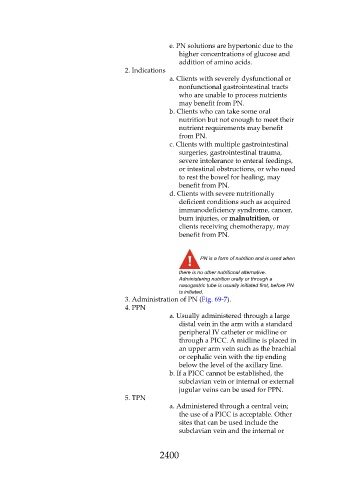Page 2400 - Saunders Comprehensive Review For NCLEX-RN
P. 2400
e. PN solutions are hypertonic due to the
higher concentrations of glucose and
addition of amino acids.
2. Indications
a. Clients with severely dysfunctional or
nonfunctional gastrointestinal tracts
who are unable to process nutrients
may benefit from PN.
b. Clients who can take some oral
nutrition but not enough to meet their
nutrient requirements may benefit
from PN.
c. Clients with multiple gastrointestinal
surgeries, gastrointestinal trauma,
severe intolerance to enteral feedings,
or intestinal obstructions, or who need
to rest the bowel for healing, may
benefit from PN.
d. Clients with severe nutritionally
deficient conditions such as acquired
immunodeficiency syndrome, cancer,
burn injuries, or malnutrition, or
clients receiving chemotherapy, may
benefit from PN.
PN is a form of nutrition and is used when
there is no other nutritional alternative.
Administering nutrition orally or through a
nasogastric tube is usually initiated first, before PN
is initiated.
3. Administration of PN (Fig. 69-7).
4. PPN
a. Usually administered through a large
distal vein in the arm with a standard
peripheral IV catheter or midline or
through a PICC. A midline is placed in
an upper arm vein such as the brachial
or cephalic vein with the tip ending
below the level of the axillary line.
b. If a PICC cannot be established, the
subclavian vein or internal or external
jugular veins can be used for PPN.
5. TPN
a. Administered through a central vein;
the use of a PICC is acceptable. Other
sites that can be used include the
subclavian vein and the internal or
2400

